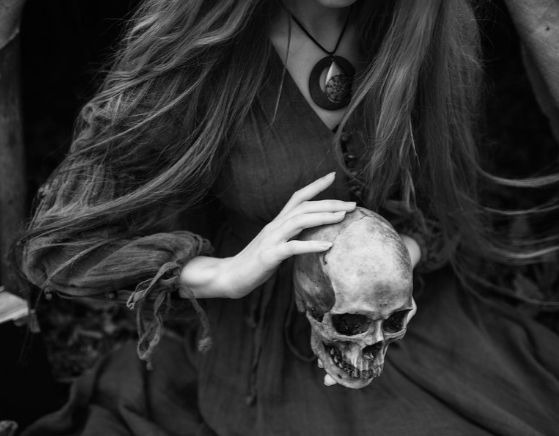Mary Magdalene, Dark Madonnas as the Archetypes of the ‘Other’ Goddess.

{source}
When investigating mythological references to the Goddesses and the Divine Feminine, I have come across some intriguing similarities, which forced me to move beyond my comfort zone to alternative and strange territories.
After all, there are many possible truths, especially on topics as manipulated and covered up as the Divine Feminine. Some of them might sound strange, but as Elaine Pagels wisely noted in The Gnostic Gospels, so are the scriptural stories in all major religions, except that we are just accustomed to them.
Mary Magdalene is a source of fascination for me, as I am deeply convinced that we lack an intelligent and truthful representation of the Divine Feminine.
Many of us feel that the Virgin Mary, who is albeit very conspicuous, especially in Catholicism, is primarily a misappropriated male fantasy of the all-loving mother. The fascination with Mary Magdalene, on the other hand, is nothing more than the search for her true story, whatever it might be, in the Western tradition.
Many scholars, mystics and intuitives feel that there is much more to her story than what we are led to believe. Usually, I honor Mary Magdalene as a disciple of Jesus as she is portrayed by the Gnostic Gospels, but I intend to share some of the more alternative explanations.
Joseph Campbell, for example, points out that there has always been more to the archetype of a goddess than viewing her as Mother Earth. And, like many scholars and researchers, he turned his attention to the Sumerian story of creation.
Why? There are some good reasons. Firstly, this story is where the Biblical version with Adam and Eve, the snake, and the tree comes from, but with a completely different interpretation. Sumeria, by the way, is arguably the first civilization in the world with Ancient Egypt and the Indus Valley, having started around 4000 BC and thus predating Biblical stories.
Secondly, it is also where the Goddess is truly predominant and powerful, in contrast to where, again, the later traditions (including the Biblical tradition) reversed or repressed the status of the Goddess. In Sumeria, Campbell says, the Goddess was much more than Mother Earth. She was the Cosmic Goddess and she created both the gods and us as her children.
Campbell gives a wonderful example of some artifacts from Sumeria. One, a sculpture, portrays the Goddess Ninmah with a snake behind her as she sits in front of the Tree of Life with her hand extended towards the Tree; on the other side of the Tree sits another god in the same position but without a snake, as Ninmah passes him the Fruit of Life.
There is no Fall in this story, as Campbell says. The Goddess is not only offering the other god the Fruit of Life, but also a refreshment of Energy. The god has horns, which in mythology symbolizes the reflective light of the moon and resurrection. Thus, by passing him the Fruit of Life, the Goddess offers him new life or resurrection.
The same basic story is repeated in the Babylonian and Egyptian mythologies/religions, which were also taken from the original Sumerian story. In Babylon, the Goddess is called Ishtar, and in Egypt, Isis, also known as The Queen of Heavens. The Babylonian and Egyptian stories repeat the same plot: of a goddess resurrecting a god through the gift of life.
There is no sin, there is no female guile or mischief. That was not introduced until much later versions which repeated the Sumerian story but made the snake the tempter and the life-giving Goddess into a not-so-bright Eve.
Now, what does this have to do with Mary Magdalene and the Dark Madonnas?
Well, to start with, in all cases the goddess was referred to as dark. And if we want to go even deeper into this, so, apparently, was the Queen Sheba, who was called dark and comely. Each time, the Goddess was involved with giving life to, or resurrecting, a young god.
This is where Margaret Starbird, who is a very devout Christian, comes in. Starbird was puzzled by the story of the virgin birth and the absence of the feminine in Jesus’ life and Christianity (apart from the rather strange story of the virgin birth).
She found the story of the virgin son born of a virgin mother somewhat unreliable, and directed her suspicions towards the removal of both the feminine and sexuality from our belief system. In her research, she found that in ancient times, both the feminine and sexuality were considered sacred.
She also discovered the ancient ritual of Hieros Gamos (Sacred Marriage): anointing of the young god/king by his goddess/bride before their marriage. Later, the goddess/bride in these ancient stories also resurrects the groom/god after he has been sacrificed.
Being a Biblical scholar, Starbird could not help but see similarities here with the story of Jesus and Mary Magdalene, albeit with the latter having been significantly edited out at some stage.
In her famous book, The Woman with the Alabaster Jar, Starbird argues that Mary Magdalene was not named so because she came from the town of Magdala, but rather her name was originally Mary Magdalen (Magdaler in Hebrew scripture means the Tower or the Daughter of Jerusalem).
Author and independent scholar Glenn Bogue also argues that Magdala may not even have existed in Jesus’ time, and thus Mary Magdalene could not have been Mary of Magdala.
Starbird concludes, as per St. Bernard of Clairvaux’s (11th-12th century influential saint who outlined the rules of the Order of the Knights Templar) suggestion, that Mary Magdalen was the same as Mary of Bethany, who, like goddesses from earlier traditions, anointed a god before their marriage.
Starbird also believes that all evidence suggests the marriage in Cana where Jesus turned water into wine was actually his own marriage to Mary Magdalen. This then repeats the story of a goddess and a god, their marriage, and the god’s resurrection (since she was the first to see him after).
Both Starbird and Bogue also make a connection with the mysterious Dark Madonna, who appeared in Europe around the 12th century, right after the French heretics known as the Cathars were killed off. The Cathars happened to be viewed as heretics for several reasons, one of them being that they believed Mary Magdalen/Magdalene was Jesus’ wife and bore him a child — a dark-skinned girl called Sara.
Starbird, Bogue and many others believe that the Dark Madonna doesn’t represent the Virgin Mary, but instead is Mary Magdalen/Magdalene — the other, dark goddess. She was a bearer of the more ancient tradition of the Cosmic Dark Goddess, dating back to the Sumerian creation story with the Dark Goddess at its center.
Indeed, both Starbird and Bogue believe that some of the greatest artists, such as Da Vinci and Botticelli, honored the Cosmic Goddess by hiding her symbols in their paintings.
Now, what does this all mean?
Many scholars, including Joseph Campbell and Jung, noticed the missing feminine link, in Western religions especially. They also noticed that this link was present in ancient traditions, but had been edited out then reinterpreted when misogyny was prevalent in Biblical times.
They also noticed that the same archetype of the Cosmic Dark Goddess as the great Creatrix of not only humans but also the Resurrecrtrix of gods has been told repeatedly in all spiritual traditions. It is the same story, but with different names.
More recently, some researchers, with Starbird the most famous, have pointed to Mary Magdalen/Magdalene as the latest manifestation of this archetype.
In the end, I am not saying that we should believe or disbelieve this story, the story of the powerful and mysterious Cosmic Goddess, the feminine we long for and want to manifest.
I do believe, however, that perhaps we should take notice of the goddess who was edited out of history but has managed to resurrect herself through the ages, hiding in plain view as the Dark Madonna, with the uninitiated believing her to be the Virgin Mary while the ones who know the ancient truths recognize her as the Cosmic Goddess, in her most recent incarnation of Mary the Magdalen.
I would love to know your thoughts about this. Also, there is much to this story which I could not cover here, but if you are interested, there is a great deal more, including tales of the Templar and some other wonderful conspiracy stories. Please let me know in your comments if you want to know more.
***
Dr. Joanna Kujawa is the author of Jerusalem Diary (a spiritual travelogue) and many short stories, essays and academic pieces. She sees herself as a Spiritual Detective who asks difficult questions about spirituality, such as ‘Can spirituality and sexuality be experienced as one?’, ‘Who was the real Mary Magdalene?’, ‘How can we include eco-spirituality in our belief systems?’ and ‘How can we bring back the Divine Feminine to create a more balanced and interconnected world?’ Her goal is to create and participate in the shift in consciousness about spirituality, our connection to nature, and our place in the Universe. She has PhD from Monash University, and MA and BA from the University of Toronto. She is immoderately passionate about her Goddess News blog. You could connect with her via her website, Facebook, Twitter or YouTube.
***
{Join us on Facebook, Twitter, Instagram & Pinterest}

